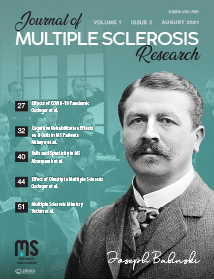Volume: 1 Issue: 2 - August 2021
| 1. | Cover Pages I - X |
| RESEARCH ARTICLES | |
| 2. | Effects of the Coronavirus Disease-2019 Pandemic on Physical Activity Level, Depression, and Anxiety in Persons with Multiple Sclerosis Asiye Tuba Ozdogar, Pınar Yigit, Zuhal Abasıyanık, Seda Dastan, Pelin Hancer, Ozge Sagıcı, Cavid Baba, Serkan Ozakbas doi: 10.4274/jmsr.galenos.2021.2021.8-1 Pages 27 - 31 INTRODUCTION: The mandatory restrictions during the Coronavirus disease-2019 (COVID-19) pandemic in regular physical activity and exercise affected the daily life of millions of people. Changes due to the COVID-19 outbreak in persons with multiple sclerosis (pwMS) are unknown. Therefore, this study aimed to examine the effects of the COVID-19 outbreak on physical activity level, depression, and anxiety in pwMS. METHODS: A total of 263 pwMS were assessed in the prospective follow-up study. Study participants in the last year were contacted by phone (from May 5 to June 5, 2020) depending on previous assessment dates, wherein 201 (154 female, 47 male) were reached during the pandemic. MS demographic and clinical characteristics were handled from the last routine examination in March 2019 to March 2020. Physical activity, anxiety, and depression information before the COVID-19 pandemic were also obtained from the assessment within the same day. RESULTS: The physical activity assessed using the godin leisure-time exercise questionnaire (GLTEQ) improved during the pandemic (p=0.018). Anxiety and depression levels significantly decreased during the pandemic (p<0.001). Significant correlations were found between the GLTEQ and anxiety and depression subscores in the hospital anxiety and depression scale (r=-0.149, r=-0.161, p<0.05, respectively) during the pandemic. However, a correlation was not found between these variables before the pandemic (p>0.05). DISCUSSION AND CONCLUSION: This study provides some evidence about the pandemic effects on physical activity level, depression, and anxiety in pwMS. The precaution taken to control the pandemic was already covered for three months; however, anxiety, depression, and inactivity behavior, which were also prevalent before COVID-19, was reduced. |
| 3. | The Effect of Cognitive Rehabilitation on Peripheral Blood B Cell Distribution and Specific Gene Expression Levels in MS patients Ece Akbayır, Melis Şen, Erdil Arsoy, Recai Türkoğlu, Vuslat Yılmaz, Erdem Tuzun doi: 10.4274/jmsr.galenos.2021.2021.8-3 Pages 32 - 39 INTRODUCTION: Multiple Sclerosis (MS) is an autoimmune, demyelinating, and neurological disorder of the central nervous system (CNS). For years, cellular immunity is thought to be the possible potential mechanism in the immunopathogenesis of the disease; however, nowadays, studies show that humoral immunity has a major part and also plays an important role. Neuropsychological tests in known to detect mild, moderate, or severe cognitive impairments that occur in patients, particularly memory and executive functions are affected. Studies showed that computer-assisted cognitive rehabilitation (CCR) studies that are performed with special software improve memory functions and change the levels of memory proteins, neurotrophic factors, and neurotransmitters in the peripheral blood. METHODS: Patients with MS (n=18) who are included in the study participated in the CCR for 6 months, and blood samples were gathered at the beginning and after the neuro-rehabilitation stage of the study. Flow cytometry is used to immunophenotype the PBMCs. The expression level of B cell-associated genes that were detected by another microarray study was determined by a real-time polymerase chain reaction. The immunophenotype and gene expression levels of the patients and 20 healthy volunteers, from whom only peripheral blood samples were taken, were compared. RESULTS: After the CCR, non-significant increased natural killer cells were observed. Regulatory B cell percentages were increased following the rehabilitation period, which differed only from healthy donors. The significantly increased transforming growth factor-beta and ATPase Na+/K+ Transporting Subunit Beta 3 gene expressions after rehabilitation was evaluated as a shift of cell activity toward immunosuppression. DISCUSSION AND CONCLUSION: The findings suggest that treatment methods, such as cognitive rehabilitation, that are not based on biological foundations may also have molecular and cellular effects. This supports its role in the regression of inflammation and clinical progression. |
| 4. | Association Between Lower Limb Spasticity and Falls in Persons with Multiple Sclerosis Zuhal Abasıyanık, Cavid Baba, Turhan Kahraman, Ozge Ertekin, Serkan Ozakbas doi: 10.4274/jmsr.galenos.2021.2021.8-4 Pages 40 - 43 INTRODUCTION: Falls and spasticity are among the most prevalent complaints in persons with multiple sclerosis (pwMS). Limited evidence exists on the direct relationship between lower limb spasticity and falls in pwMS. This study aimed to explore the association between lower limb spasticity, walking, and falls in pwMS. METHODS: Thirty-nine patients were included (age: 35.4±9.52; 54% female, 46% male). The timed 25-foot walk (T25FW) and multiple sclerosis walking scale-12 (MSWS-12) were applied to evaluate walking. Participants reported their number of falls within the last three months. The severity of spasticity in lower limb muscles, comprising hip adductors, knee flexors and extensors, and plantar flexors, was tested using the modified ashworth scale. RESULTS: Fifteen participants were fallers. Spasticity levels in the ankle plantar flexors were significantly greater (p=0.009) in fallers. The number of falls correlated with ankle plantar flexors and knee extensors (rho=0.497, rho=0.329; p<0.05, respectively). The severity of spasticity in all muscle groups was negatively correlated with walking (rho=0.335-0.692, p<0.05). DISCUSSION AND CONCLUSION: There was a significant correlation between the degree of ankle plantar flexor and knee extensor spasticity and the number of falls in pwMS. This significant association between spasticity and fall history highlights the importance of designing therapeutic interventions optimizing lower limb spasticity. |
| 5. | The Association of Obesity with Walking and Balance Control in Fully Ambulatory People with Multiple Sclerosis According to Two Different Classifications Asiye Tuba Özdoğar, Turhan Kahraman, Ozge Ertekin, Cavid Baba, Serkan Ozakbas doi: 10.4274/jmsr.galenos.2021.2021.8-2 Pages 44 - 50 INTRODUCTION: Previous studies have reported that people with obesity have slower walking speed, poor balance control, and more energy expenditure during gait than patients without obesity. However, little is known about the effect of obesity on walking and balance control in people with multiple sclerosis (MS). This study aimed to investigate the associations of obesity with walking and balance control in fully ambulatory people with MS using two different obesity classifications. METHODS: This study included 210 fully ambulatory people with MS. Obesity classification recommended for MS and obesity classification by the World Health Organization (WHO) were used. Outcome measures included walking speed [timed 25-foot walk (T25FW)], walking endurance [six-minute walk test (6MWT)], perceived walking impairment [12-item ms walking scale (MSWS-12)], and balance control [timed up and go (TUG) test]. RESULTS: According to recommendations for MS and WHO classification, 105 (50%) and 28 (13.3%) participants were classified as obese, respectively. Both groups revealed that patients who are overweight and obese have lower scores in T25FW, 6MWT, and TUG tests, whereas higher scores on the MSWS-12 than patients without obesity, with a significant difference (p<0.05). DISCUSSION AND CONCLUSION: People who are overweight and obese with MS have poorer performance on walking speed, walking endurance, perceived walking impairment, and balance control than non-obese counterparts. Future longitudinal studies should investigate the effects of losing weight on walking and balance in people with MS. |
| CASE REPORT | |
| 6. | Subdural Hemorrhage Mimicking Relapse in a Patient with Multiple Sclerosis Mehmet Fatih Yetkin, Merve Akcakoyunlu, Mehmet Fatih Gol, Meral Mirza doi: 10.4274/jmsr.galenos.2021.2021.9-2 Pages 51 - 53 Multiple sclerosis (MS) is an immune-mediated disease of the central nervous system, which is more common in young adults and can present with various clinical manifestations. The emerging neurological findings in the course of MS are often considered as relapses; however, neurological deterioration may have other treatable causes than relapses. No data are indicated in the increased frequency of the overall hemorrhagic stroke in individuals with MS, thus the coexistence of MS and subdural hematoma has been rarely reported. This study presents a 49-year-old male patient with a subdural hematoma that mimics a relapse. Recently emerging neurological symptoms in the course of MS frequently indicate a new demyelination event; however, emerging neurological symptoms may have other treatable causes besides relapse, especially in the presence of red flags such as headaches. |














 Copyright © 2024 | Journal of Multiple Sclerosis Research
Copyright © 2024 | Journal of Multiple Sclerosis Research